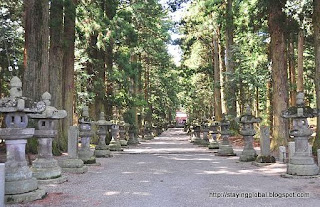Mount
Fuji needs no introduction. It has always been a symbol of Japan till this day
remains on every tourist’s list of must visit places in Japan. Mount Fuji’s
near perfect conical shape is the result of its multiple eruptions and lava
flows.
Mount
Fuji’s multiple eruptions have also resulted in the formation of the Fuji Five
Lakes, also known as Fuji-go-ko. Fuji Five Lakes is the area located around the
base of Mt Fuji’s northern half and is located in Yamanashi Prefecture. In
recent years, Fuji Five Lakes which form part of the Fuji-Hakone Izu National Park, has become
a much visited tourist attraction. The lava flows from Mt Fuji’s eruptions
dammed rivers and resulted in the formation of these five lakes. All of the
lakes are considered to be excellent fishing spots and have been developed into
tourist spots atleast to some extent.
The
Five Lakes that form part of Fujigoko are Lake Kawaguchi, Lake Yamanaka, Lake
Saiko, Lake Motosu and Lake Shoji. All lakes also provide good views of Mt
Fuji, on days when the sky is clear and weather is good. Spring and Autumn when
the flora and foliage are at their best and most colourful are preferred
seasons for visiting Fuji Five Lakes.
On
our recent trip to the Fuji-Hakone area, we visited two of these lakes- Lake
Yamanaka and Lake Kawaguchi. Our
first stop was Lake Yamanaka. Yamanaka-ko as the lake is also known is the
easternmost and largest of the five lakes.
Located at an altitude of 980 metres
above sea level, it is also the third highest lake in Japan. The lake has a
circumference of 13 kms and offers good views of Mt Fuji from its northern
shore on clear days.
However on the day of our visit, the sky was cloudy and as
such we could not see even the slightest trace of Mt Fuji.
Yamanaka ko is popular among visitors for
Boating, fishing and other water sports and ranks as the second most developed
of the five lakes behind Lake Kawaguchi.
In recent years Yamanaka ko is
emerging as the most popular of the Fuji Five Lakes.
After
visiting Lake Yamanaka, we drove up further to Lake Kawaguchi. On the way to
Lake Kawaguchi, we briefly stopped at the Fujiyoshida Sengen shrine.
Lake
Kawaguchi also known as Kawaguchi ko, is the most popular of the Fuji Five
Lakes. This lake also has a circumference of 13 kms and this too offers good and
unobstructed views of Mt Fuji on clear weather days and is a photographer’s
delight. Most images and calendar pictures of Mt Fuji forming the backdrop of a
lake are said to be taken from one of the shores of Kawaguchi-ko.
Unfortunately
we visited the lake on a cloudy day and as such we could not view Mt Fuji. Kawaguchi is the only lake amongst the Fuji Five Lakes to have an island.
Kawaguchi
ko is the most developed of the five lakes and there is no dearth of hotels and
other accommodation in Kawaguchi town which has turned to a popular holiday
resort.
Visitors can indulge in various water sports at Lake Kawaguchi. The
Subaru toll road which leads up to Kawaguchi ko 5th Station begins
from close to the Kawaguchi IC. Kawaguchiko 5th station serves as a
starting point for climbing Mt Fuji.
Lake
Saiko, also known as Saiko-ko is located just about 1 km to the west of Lake
Kawaguchi and thus is also called the Western Lake. The western side of Lake
Saiko shares its banks with the Aokigahara Jukai forest. The lake has a
circumference of 10.5 kilometers but the lake is not much developed. However,
there are many camp sites located along the lake’s shores.
Lake
Shoji, also called Shoji-ko, is the smallest of the five lakes wth a
circumference of 2.5 kms. Rocks jutting out of the lake are remnants of lava
flow and these days used by locals fishing in the lake’s water. Fishing and
boating are popular outdoor activities at Lake Shoji.
The
last of the five lakes is Lake Motosu, which at 140 meters, is the ninth
deepest lake of Japan. Motosu lake along with Lake Saiko and Lake Shoji was
formed by lava flowing through the area which is now Aokigahara Jukai Forest.
The lava separated a large prehistoric lake in the area thus resulting in the
formation of the three lakes. These three lakes are still connected by means of
underground waterways and are also said to maintain the same surface level of
900 meters above sea level. The lake has a circumference of 13 kms .The picture
of Mt Fuji on the 1000 yen note is said to be a depiction of the view of Mt
Fuji from near Lake Motosu. The shores are not much developed barring few
camping grounds.
The
Aokigahara Jukai Forest is an expansive forest south of Lake Saiko which has a
network of hiking trails and is reputed to be easy to get lost in. This area is
also infamous as a suicide spot. Past lava flows have also resulted in the
formation of several caves around the Aokigahara Jukai Forest. Three of the
lakes – Ice Cave, Wind Cave and Bat Cave have become popular tourist
destinations.
The main city in the Fuji Five
Lakes area is Fujiyoshida city, which is also popular for the Fuji Q Highland. Kawaguchiko area also has a variety of museums like the Yamanashi
Gem museum, Kawaguchiko Music forest, Kawaguchiko Museum of Art etc. Udon
noodles are a popular delicacy from the region.





































































